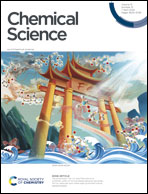Nanoparticle-directed bimodal crystallization of the quasi-1D van der Waals phase, Bi4I4†
Abstract
Anisotropy often yields unexpected structures and properties in the solid state. In van der Waals (vdW) solids comprised of 1D or quasi-1D (q-1D) building blocks, anisotropy in both intra- and inter-chain directions results in an abundance of crystalline packing motifs and drastically altered physical states. Among these, structurally and chemically complex 1D/q-1D vdW solids that display topologically protected states, unique optical properties, and enhanced electrical transport properties in 1D are sought after owing to their potential as building blocks for next-generation quantum devices that approach the sub-nanometer regime. Yet, the access to such facet- and edge-specific physical states is still limited by the stochastic nature of micromechanical exfoliation. Here, we demonstrate that the representative Bi4I4 phase, an established pnictohalide q-1D vdW topological insulator in the bulk, can be crystallized from the vapor phase either into well-defined nanowires or quasi-2D nanosheets. We find that gold nanoparticles (Au NPs) on the growth substrate, in conjunction with the highly anisotropic structure of Bi4I4 common to many q-1D vdW crystals, direct the dimensionality of high-purity Bi4I4 nanostructures. Systematic variation of Au NP diameters, Bi : I precursor ratios, and growth-deposition temperatures reveal that Au NPs generally act as nucleation sites for vapor–solid (VS) growth of Bi4I4 nanowires. Strikingly, post-synthesis analyses of the elemental composition of 20 nm Au NPs on the substrate surface show an equisotichiometric 1 : 1 ratio of Bi to I within the Au NP that triggers the vapor–liquid–solid (VLS) growth of [001]-oriented quasi-2D nanosheets comprised of laterally-ordered [Bi4I4]n chains along the perpendicular [100] direction. We rationalize the observed bimodal growth pathways and the morphologically distinct nanostructures based on crystallization habits and orientations of the nanostructures, Bi : I ratios in the resulting Au NPs post-synthesis, and the orientation of stereochemically active Bi lone pairs between adjacent chains. We anticipate that these growth pathways are adaptable to the synthesis of emergent halide- and chalcogen-based 1D vdW nanocrystals with diverse physical and quantum properties.

- This article is part of the themed collection: 2024 Journal of Materials Chemistry Lectureship runners-up: Maxx Arguilla and Phillip Milner


 Please wait while we load your content...
Please wait while we load your content...